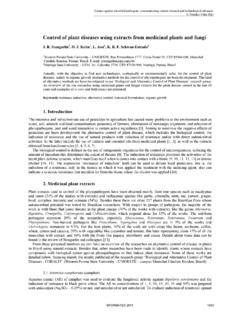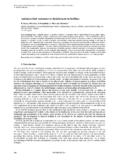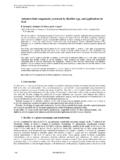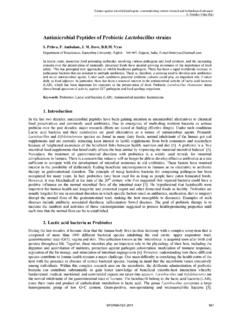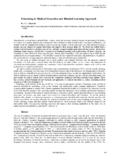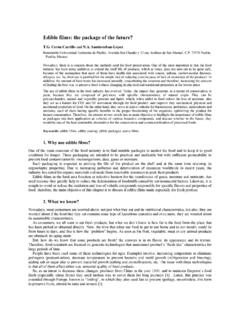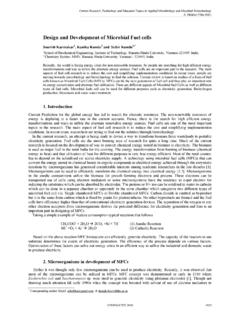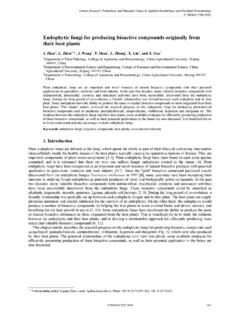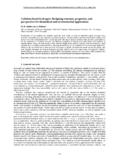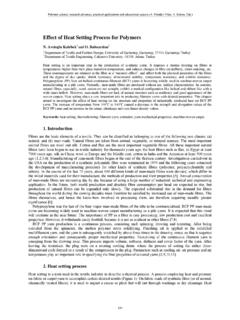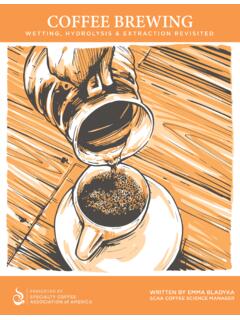Transcription of Application of Near Infrared Spectroscopy (NIRs), PCA and ...
1 Application of Near Infrared Spectroscopy (NIRs), PCA and PLS models for the analysis of dried medicinal plants J. Gajdo Kljusuri , D. Valinger, A. Jurinjak Tu ek, M. Benkovi and T. Jurina Department of Process Engineering, University of Zagreb, Faculty of Food Technology and Biotechnology, Pierottijeva 6, 10 000 Zagreb, Croatia In traditional medicine, botanicals and medicinal plants in their natural and processed form are widely used [1] due to their medicinal and antioxidant properties. Numerous analytical methods have been developed for the analysis of chemical composition of medicinal plants extracts like gas chromatography (GC), mass spectrometry (MS), thin layer chromatography (TLC), UV spectrometry, and high performance liquid chromatography (HPLC). All these methods are precise but expensive, time-consuming and require many reagents.
2 As an alternative, near Infrared Spectroscopy (NIRs), as a simple, selective, and environmentally friendly method [2], can be used. NIR Spectroscopy is a non-destructive measurement method that allows intact measuring, without any additional sample preparation or pre-treatment. Use of Spectroscopy in the near Infrared region allows a wide range of applications in the food chain production, from control of raw materials to intermediary and final products [3] in order to provide a quality guarantee for consumers. NIR Spectroscopy is based on the electromagnetic absorption in the near Infrared region. Spectral analysis has to be assisted with various chemometric techniques, such as multiple linear regression analysis (MLRA), principal component analysis (PCA) and partial least squares regression (PLSR) [4].
3 Chemometric techniques and chemometric modelling have become an integral part of spectral data analysis which also includes pre-processing of NIR spectra. The pre-processing objective is removal of physical phenomena in the spectra in order to improve the subsequent multivariate regression, classification model or exploratory analysis [5]. In this work, most widely used pre-processing techniques including (i) scatter-correction methods and (ii) spectral derivatives are explained through analysis of spectra of dried medicinal plants collected during the size reduction process (milling), as well as during analysis of the kinetics of the solid-liquid extraction process using water as a solvent [6]. In order to identify patterns in large set of data and express the data to highlight similarities and differences among them, PCA was used.
4 PCA presents the pattern of similarity of the observations and the variables by displaying them as points in maps [7]. PLS regression was used to predict or analyse a set of dependent variables from a set of independent variables or predictors. The predictive ability of a PLS model is expressed as one or more statistical measures. Which parameter should be used is described by R-Squared Coefficient, Ratio of standard error of Performance to standard Deviation (RPD) and Range Error Ratio (RER). Keywords: near Infrared Spectroscopy ; data pre-processing, modelling, principal component analysis, partial least squares regression 1. Introduction Our fast-paced modern lifestyle leaves us very little time for regular nutrition and care for our health leading to increased occurence of chronical disseses such as cancer, vascular diseases and neurodegenerative diseases.
5 Medicinal plants have been used since ancient times for treatment of a wide range of diseases and are the richest bioresource of drugs for traditional systems of medicine, modern medicines, nutraceuticals, food supplements, folk medicines, pharmaceutical intermediates and chemical entities for synthetic drugs [8]. Since medicinal plants represent a rich source of biologically active compounds that have a beneficial effect on health, a wide range of medicinal plants can be found on the market today. Studies have been carried out globally to verify their efficacy and some of the findings have led to the production of plant-based medicines. Some of the health benefits of medicinal plants include antimicrobial and antioxidant efficacies, which can be of great significance in therapeutic approaches of many diseases [9].
6 Up to this day, there have been several studies documenting the antibacterial, antifungal, antiviral, anticancer and anti- inflammatory properties of plant ingredients [10, 11, 12]. With the rapid increase in sale and variety of medicinal plants there is a growing concern for quality of the products present on the market. Although there are many methods for quality control such as HPLC, GC, MS, TLC etc., there is still demand for less expensive, consistent, rapid and non-destructive method. A significant number of literature reports have emerged over the past 20 30 years regarding the use of near Infrared Spectroscopy (NIRS) as both a research tool for formulation development and as a quality control technology for monitoring unit operations for product manufacturing [13]. It is well known that NIR spectra contains both chemical and physical information (such as particle size and bulk density) [14, 15, 16] thus regular or in-line particle size measurement can be one of the ways to control the quality of certain products where medicinal plants are used as raw materials or as extracts for their production.
7 The aim of this study was to examine the possibility of differentiating particle size of the same plants and the different particle size of different plants and also to show the potential of Partial Least Squares Regression (PLSR) models for prediction of different parameters such as conductivity, dry matter, total disolved solids (TDS) and total polyphenols (TP) based on NIR spectra. The non-invasive Spectroscopy in the near Infrared range of 904 - 1699 nm (NIR) was used to record spectra of five different medicinal plants (sage, lavender, lemon balm, thyme, mint) for seven different particle sizes (<100 m, 100 m, 250 m, 355 m, 500 m, 800 m and 1000 m) that were further used for diferentiation of different particle sizes by Principal Component Analysis (PCA). Except crude medicinal plants, water extracts of medicinal plants were also investigated (marigold, sage, lemon balm, thyme, St.)
8 John's wort and lavender) by PCA. PLS regression modelling was performed on lavender water extract as part of study for the project Application of microreactors in the analysis of antioxidant activity of medicinal plants (MICRO-AA) , project number 0069, which was funded by the European Social Fund (ESF) through the Human Resources Development program. Results have shown that NIR Spectroscopy was successful in differentiating particle sizes of different plants and highly sensitive to different particle sizes of the same plants. PLS regression modelling results show a very promising potential in monitoring certain physical and chemical properties of medicinal plants water extracts by NIR. Spectroscopy . 2. Materials and methods Materials Plant material Dried plant materials of sage (Salvia officinalis L.
9 , lavender (Lavandula angustifolia L.), lemon balm (Melissa Officinalis L.), thyme (Thymus vulgaris L.), mint (Mentha piperita L.), marigold (Calendula officinalis) and St. John's wort (Hypericum perforatum) collected in the north-western part of Croatia during the flowering season of 2015, dried and properly stored, were purchased from a specialized herbal store (Suban , Strmec, Croatia). Chemicals and reagents Folin-Ciocalteu's reagent and sodium carbonate were purchased from Kemika (Zagreb, Croatia). Trolox (6-hydroxy- 2,5,7,8-tetra methylchromane-2-carboxylic acid) and potassium peroxodisulphate were obtained from Fluka (Buchs, Switzer land). ABTS + (2,2'-azino-bis(3-ethylbenzothiazoline-6 -sulphonic acid)diammonium salt), gallic acid (3,4,5- trihydroxybenzoic acid) were obtained from Aldrich (Sigma Aldrich Chemie, Steinheim, Germany), and ethanol (96%).
10 Was obtained from Carlo Erba Reagents (Cornaredo, Italy). Methods Milling Dried plant material of sage, lavender, lemon balm, thyme and mint was milled using IKA control Tube mill (IKA- Werke, Staufen, Germany). Milling conditions were adjusted as follows: 20 000 min-1 for 40 seconds. Since the plant material had different organic structures and thus different hardness, for some samples milling time was reduced to 20. seconds. After milling, samples were kept in a desiccator until further used. Separation of particle size fractions In order to separate the particle size fractions milled plant material was subjected to sieving. Used sieves had 100 m, 250 m, 355 m, 500 m, 800 m and 1000 m pore opening. Seven different particle size fractions were obtained marked as <100 m, 100 m, 250 m, 355 m, 500 m, 800 m and 1000 m which were then subjected to NIR.
